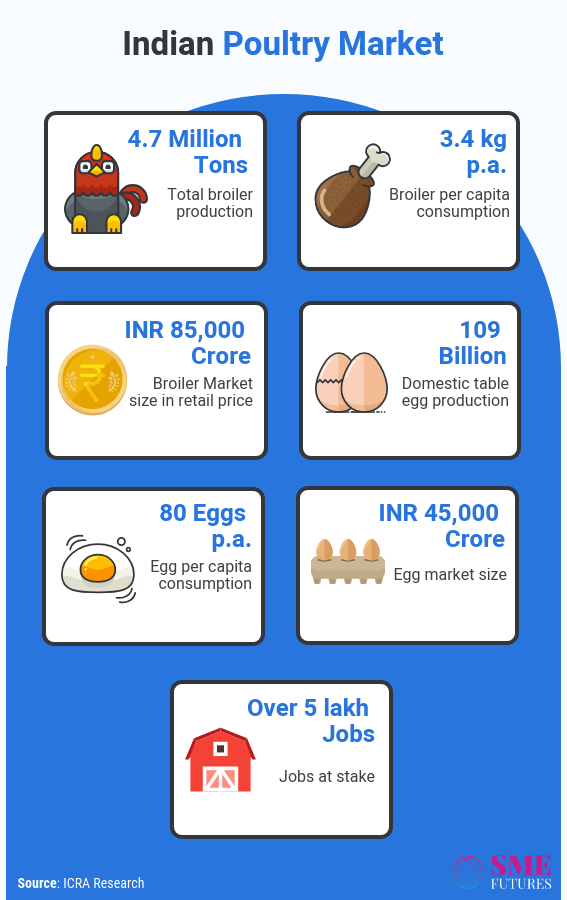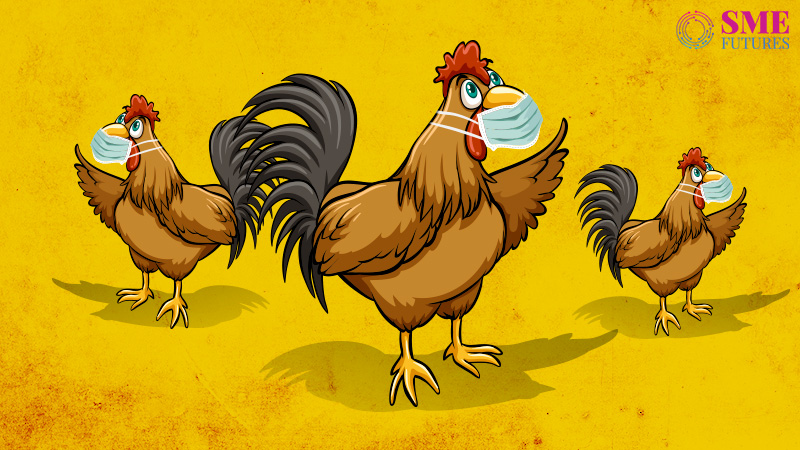A Noida-based home maker Nibha Singh banned non-veg food items in her household, and so as many people across the country. Moreover, like any other industry, the lockdown – resulting in a broken supply chain – made the movement of the poultry industry equally difficult, adding to their woes.
Due to a false rumour, according to a top supplier Godrej Agrovet, Indian poultry sales saw a decline by 50 per cent even before the lockdown started.
“A lot of misleading posts on social media, especially on WhatsApp, have created a false impression that humans can contract the coronavirus through chickens,” says Godrej Agrovet MD B S Yadav.

As a result, the rumours surrounding the spread of coronavirus through animals and chicken and the lockdown turned out to be a double whammy for poultry players. People are avoiding consumption of meat, fish, chicken, and egg etc. Due to the fall in demand, wholesale price of chicken had dropped by as much as 70 per cent. As a result, chicken was now available at Rs 60-150 per kg in retail compared with Rs 180-200 earlier on.
Maharashtra-based Suresh Bhatlekar, an owner of 35 poultry farms, destroyed Rs 5.8 crore worth of poultry products due to lack of demand. In another shocking incident, a poultry farmer from Belgavi, in Karnataka, buried thousands of chickens alive to avoid the spread of Covid-19. Bulandshahar district of Uttar Pradesh witnessed a similar incident of nearly 6,000 chicks being burnt alive. While others are just giving them for free due to decline in sales.
There are many such cases across India. These rumours – more than the coronavirus pandemic itself – have created more disruption in the sector. Due to this crisis, many poultry businesses are on a verge of shutting down.
According to the apex body All India Poultry Breeders Association (AIPBA), the poultry sector is staring at a loss of Rs 22,500 crore.
“Rumours began doing the rounds in the first week of February, which affected us very badly. Some people spread false information that chicken and eggs should not be consumed. The adverse impact continued for about six weeks,” AIPBA Vice President Suresh Chitturi said.
Indian poultry in pain
Chicken is arguably most popular poultry meat consumed in the country. In 2019, there was a gradual increase in the consumption. Research platform Statista reported that over 3.8 million metric tons of poultry meat was consumed across India last year.
Indian consumers have a greater affinity for broiler meat, which constitutes about 95 per cent of the total volume of sales compared to the processed chicken meat segment that accounts for the remaining 5 per cent, says Dr. Arun Singh, chief economist at Dun and Bradstreet India.
Commenting on the Indian consumption habits, Singh adds, “While India is the fifth largest poultry producer in the world, the rate of consumption is very low. Per capita consumption of chicken meat in India stands at around 3 kg per annum per person compared to 17 kg globally.”
According to a study by ResearchandMarkets, the Indian poultry market, consisting of broilers and eggs, was worth Rs 1,750 Billion in 2018. The market was further projected to reach Rs 4,340 Billion by 2024, growing at a CAGR of 16.2 per cent.
In 2019, domestic table egg production stood at 109 billion eggs, translating to the consumption of nearly 80 eggs per capita per annum. And, the market size stood at over Rs 45,000 crore. While total broiler meat market size reached Rs. 85,000 crore in terms of retail price, according to ICRA Research.
In the pre-Covid era, the overall domestic poultry industry witnessed a healthy 13 per cent revenue growth in FY 2019.

But the future looks bleak.
In retail market, poultry shop owners are struggling to stay in business as chicken price has come down to Rs 20 per kg in some places.
Ravi Shankar Nath Tiwari, director at a West Champaran-based company, Champaran Agro, informs that chickens are produced on a large scale but the rumour surrounding the spread of the virus has destroyed all the business. “It costs about Rs 24 to prepare a chick. And with no one buying them, over one lakh chickens were buried in the ground,” Tiwari adds.
It costs about Rs 80 to prepare a broiler chicken, but due to fake rumours businessmen have started selling each chick for as low as Rs 10-30, he shares.
However, it’s not the first time that on social media birds are linked to diseases. There have been such outbreaks in the past with diseases such as bird flu – that resulted in culling of millions of birds.
After the outbreak of the pandemic, 18,000 chickens were culled in the Hunan province of China as a result of a H5N1 flu outbreak in the province.
Upfront losses at the farm gate
The survival of both big and small firms is at risk. Even the Ministry of Animal Husbandry, Dairying and Fisheries admits the adverse effect on poultry industry, adding that the poultry industry was losing Rs 1,500-2,000 crore daily.
Meanwhile, Minister of State Sanjeev Kumar Balyan also said that the wholesale prices of chicken had come down by 70 per cent.
Singh from D&B adds, “Poultry farming is one of the worst hit sectors due to the outbreak of Covid-19. Prices of chicken and eggs have dropped by 70-80 per cent. Poultry farmers are now facing losses at the farm gate.”
In the current market scenario, poultry birds were being sold at a price of Rs 10 to Rs 30 per kg at the Farm Gate level due to fake news. The production cost of poultry in India was Rs 80 per kg, the AIPBA stated that the prices of eggs have plunged to two rupees per egg at farm gate.
Even the National Egg Coordination Committee (NECC), in Namakkal, has reduced egg price by 70 paise and fixed it at Rs 1.95 as large quantities of eggs remain unsold. On an average, the cost of production of an egg is Rs 4.
The broiler segment is incurring weekly losses of around Rs 7-8 billion from the sale of chicken alone. This figure would be much larger when the losses from eggs are also accounted for, Singh believes.
“On a micro level, given that the average farm size in India is 8,000 birds with a 40-day production cycle, a typical poultry farmer would lose around Rs 1 million,” he informs.
Apart from poultry owners and farmers, the ancillary segment too is feeling the heat. Purshottam Kaujalagi, a senior official at Dhumal Industries, a company that provides equipment (such as feeding systems, manual feeders, water systems, drinker heating systems and ventilators) – to the poultry industry, admits that their business has been severely affected in the past one month. While another official of a poultry feed company informs that their sales have stalled, and they have stopped the purchase of maize and soyabean and other items to prepare the chicken feed.
There is a cascading effect of the rumour also on the farmers growing corn and soybean; and the soy industry. Lately, the price of maize had come down by Rs 7,000 per tonne.Halted supply chain hits processed chicken demand too
Indian remains predominantly a live bird market with close to 90 per cent of broiler sales being done at traditional retail counters. However large integrators are investing hugely into the processing infrastructure for food to home services.
Having said that, consumers in India prefers live or wet market poultry products, and the mind-shift towards processed meat will take time.
On the other hand, the processed meat market exists and is still at its nascent stage with less than 10 per cent market share. The coronavirus blow and the lockdown have caught the sector unwarned.
One such omni-channel fresh meat and seafood aggregator in South India tackling the crisis tells SME Futures that Covid-19 has turned out be an induced shock for the complete supply chain industry.
“People were staying indoors, hence the demand has spiked but facilitating to their need became a challenge, both in terms of supply of goods and delivery to the customers,” Chennai-based TenderCuts founder and CEO Nishanth Chandran adds.
This has also impacted the demand from restaurants and Quick Service Restaurants (QSR) chains with the demand recovery likely to happen gradually, post relaxation in the lockdown. But, the overall demand for processed meat will remain muted in FY2021.
Jobs at stake
The entire poultry community is under stress as lockdown has been extended – also affecting over 5 crore direct and indirect employment generated by the poultry farming industry. These people are engaged in poultry production, trading, feed manufacturing, agriculture crops, logistics, exports and others.
According to the breeder association, the industry employs more than 10 lakh poultry farmers and contributes Rs 1.3 lakh crore to the country’s GDP directly. The sector also provides a direct benefit to more than one crore maize and soya agriculture farmers.
Singh explains that the losses of this magnitude with no signs of imminent price recovery are expected to drive many poultry farmers out of business.
“The overall impact on the poultry sector will have spillover effects on allied sectors such as livestock feed, medicines and vaccine manufacturers, and equipment providers. For every four jobs generated in the poultry farm, one job is generated in the allied sectors. Hence the economic implications of this crisis are widespread,” he believes.
Singh, however, feels the unorganized sector is going to feel the most brunt. “Over 30 million farmers are engaged in backyard poultry. This is not only a source of income for many marginal farmers but also a source of nutritional security to the rural poor.”
Industry seeks government help
Poultry sector comes under the ‘vulnerable’ category and includes large number of MSMEs, small businesses and daily wage earners. Even on the global forum, chicken meat trade is said to be revised 4 per cent lower to 11.7 million tons on downward revisions for all major exporters except Brazil.
As a result, world chicken meat trade will contract by 1 per cent in 2020 compared to last year.
In view to curb crisis in the sector, the AIPBA has submitted a memorandum to Prime Minister Narendra Modi, on March 30, seeking “urgent financial assistance and rescue package” for the industry.
Chitturi said the association has requested a restructuring of loans, allowing conversion of existing working capital loans cash credit (CC) limits to term loans with two years moratorium. “The government should offer interest subvention and issue fresh working capital.”
All small farmers with less than 20,000 capacity farms should be provided with a compensation of Rs 100 per bird based on their chicks’ purchase bill paid through banking transactions, the association mentioned in the memorandum.
The breeders association also appealed to the Centre to provide wheat and rice of ‘Feed Grade’ from the old stock of government, at a subsidized rate of Rs 10 per kg. It further sought exemption of GST on soya seed and soya meal, which has added to the input cost on livestock feed to the farmers.
The total loss to the poultry industry in two-and-half-months beginning February this year is pegged at Rs 22,500 crore.
However, the level of risk averseness remains very high as evidenced by low consumptions rates. Prices may rebound once the outbreak of the virus subsides.











